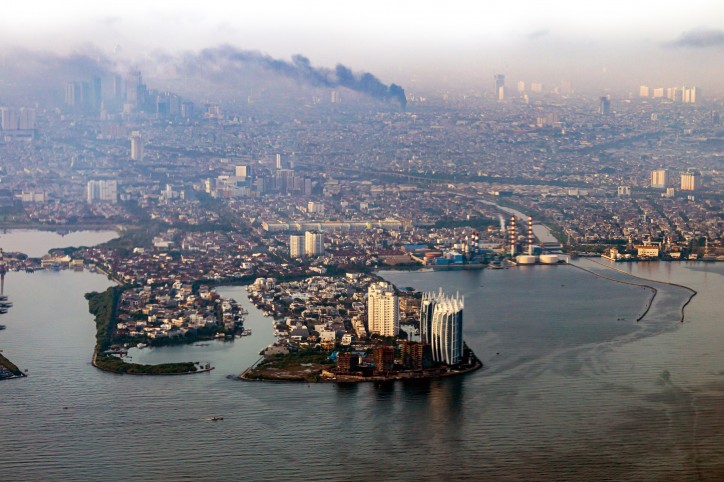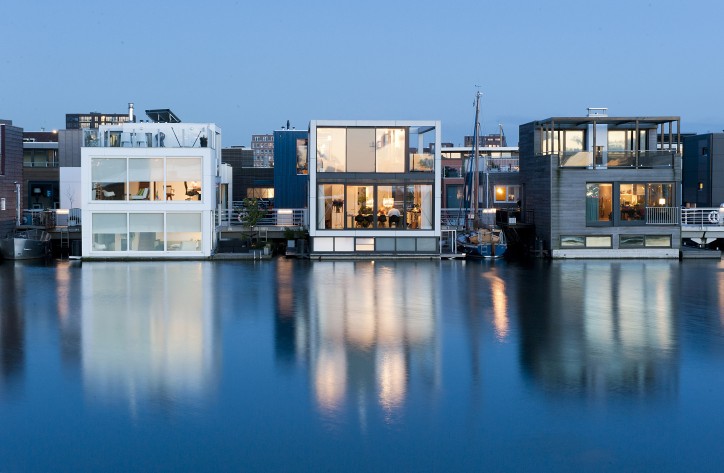Floating Homes Architectural Solutions to Sea Level Rise
By Lukasz Stepnik
Translated by Aga Zano
2019.April.29
As we all know, when Yahweh unleashed a great flood upon humanity, he saved Noah and his family by ordering Noah to build an ark. This story was recorded not only by Jews, but also by other nations, such as the Sumerians and Mesopotamians (except their God was called Ea or Enki, and those saved from the deluge were known as Utnapishtim or Ziusudra). Clearly, they were all onto something. No wonder people of reason are preparing for another flood to come – even in Poland, too.
In the 1995 film Waterworld, Kevin Costner’s character – a fish-like mutated human sailing the endless ocean – takes his beloved Helen for an underwater journey. There, he shows her the drowned ruins of New York City. Corals cover reinforced concrete structures that look like the haunted graveyard of a once-glorious civilization that brought doom upon itself. Scarce dialogues make it difficult to deduce the exact cataclysm that resulted in the world’s submergence under water, but we can assume it was to do with melting ice caps and the immense amounts of carbon dioxide emissions that had been seeping into the atmosphere for decades.
Is the deluge coming for us?
That’s right!
Most scientific prognoses for the Earth’s future look not unlike the Kevin Costner film. This makes the screenwriters for Waterworld pioneers of environmental enlightenment, who educated the masses on the dangers of global warming. Realistic calculations estimate that by the year 2100, ocean waters will rise by 1.5 metres. The Maldives and Bahamas will disappear from maps, just like many European coastal cities and towns that offer luxury seaside vacations. Such a rise in the water level will threaten the lives of over 150 million people living in flooded areas, causing mass migration, and a radical reshuffling of the global economy and politics.
Some of these changes are now beyond remediation. Therefore, the question of time is essential. How long will humans need to adapt to this new reality? Most of the infrastructure created today, such as homes and public buildings, will most likely still exist several decades from now. Thus they should be designed with contingency planning in mind for the worst climate-change scenarios. In the meantime, it appears obvious that this is the last thing politicians and developers want to consider; they are usually interested in little else than their own short-term investment return. Even one of Poland’s most famous modern urban projects – the Wilanów suburb in Warsaw – was built entirely on a flood zone. One day, it might become a financially-attractive alternative to Venice.
Polders in Jakarta
The fastest-drowning city today is Jakarta, located by the Java Sea, which is part of the Pacific Ocean. The northern part of the city has to deal with an annual water level increase of 25 centimetres. This, however, isn’t due solely to global warming – local laws allow all inhabitants to dig their own wells, which leads to a gradual collapse of the ground. Indonesia is trying to save its capital with the aid of Dutch engineers, who have suggested building a network of enormous polders along the coastline. Polders are low-lying areas that fall below the sea-level, but are enclosed by barriers. This solution would help to separate the northern parts of Jakarta from the sea, and double as emergency reservoirs that would contain excess water during a crisis.
The government of Jakarta backed out of its initial idea of creating a new business district on an artificial island shaped like the mystical Garuda bird (a man-eagle of sorts), which would have isolated the coast from the sea. This concept, inspired by Dubai’s urban planning solutions, was eventually abandoned in favour of a less spectacular but more innovative strategy to deal with the consequences of climate change. It involves filling polders with floating homes that could remain safely on the water surface during floods. This solution will also allow commercial use of an area that is utterly useless for traditional construction techniques.

It is no coincidence that Jakarta hired the Dutch to oversee the project of preparing the city for changes in water levels. Apart from the colonial ties linking the two nations, the Dutch have been experts in reclaiming flooded areas for new projects for centuries. They have perfected the art of building on water, too. Amsterdam invests billions of euros in preventing the city from drowning, and it promotes living in floating homes.
The sea won’t see it coming
The IJburg district, located south of Amsterdam’s city centre, was built on four artificial islands connected by bridges. Between the islands, dozens of floating homes are bobbing along the shores, moored to the islands and using the city’s infrastructure. The continually growing community of IJburg is known for its liberal world view (even by Dutch standards), and at its core are young, well-educated, middle-class people. They consider inhabiting the sea a chance to realize their dreams of living close to nature. Life on a barge or a floating platform today is a hippie extravagance. Soon, it might become a necessity.

“The Netherlands has long been a pioneer in reclaiming land from water, spending centuries drying out the sea to build. That may have been a mistake,” says Koen Olthuis, an architect and the founder of Waterstudio (an architectural firm that designs floating buildings). When so much land is threatened by floods, perhaps it’s better to invest in a house that can double as a boat, should crisis strike? This is an intriguing alternative for traditional urban planning, but it’s not a new idea. For centuries, Cambodians, Indians and Nigerians have built many towns and villages on areas flooded during rainy season, or just covered in water all year long. Some have created stilt houses, while others have preferred floating platforms that allow the settlements to move during immediate dangers, but also to acclimatize to changing weather conditions.
Such dynamically changing urban development principles could have a significant impact on the ways we all use our cities. It could lead to removing the attachment to particular patches of land. In many densely-urbanized areas all over the world, the amount of dry land available for new building projects is continuously shrinking. This means that throughout the years, there will be more people willing to move their homes to water. It can already be observed in data from the Netherlands, Denmark, Britain and France, where serious consideration is given to creating whole districts made entirely of floating homes.
Koen Olthuis is convinced that this type of building is the best solution for the architecture of the future. His projects are made not only for residential housing; he also designs floating hospitals, schools and theatres. They can easily travel between cities or districts, enriching the infrastructure and reaching places where they are most needed at the moment. However, his strategy raises many questions – most people don’t view living on water as a guarantee of permanence. This opinion is further cemented by news of disasters, like the recent collapse of the most famous floating construction, a school in Makoko, Lagos. The school, designed by the Dutch architectural firm NLÉ, drowned after heavy rain. Many ecologists also highlight the fact that too many floating buildings could affect riverbeds and shorelines, damaging the local fauna and flora. On the other hand, several units could have a surprisingly positive impact on the environment. Floating homes are a fantastic base for the development of underwater ecosystems, because they promote the growth of plants that significantly improve the biodiversity of the habitats of various fish and birds.
This has happened underneath several residential barges, whose impact on the environment was recently analysed by a team of London scientists. As it transpired, the barges are now home to more tenants than just the handful of humans who live inside.
Vistula tenants
Prototype water estates are also appearing in Poland. In the Czerniakowski Port in Warsaw, there are already several residential barges with permanent tenants. The only problem is the lack of space in the port, which makes it impossible to add more vessels to the neighbourhood. And the queue is long, as such floating homes are a tempting alternative to land property. Living on a barge is a bargain. The vessels are prefabricated and assembled of ready-made elements, which means a brand-new home could cost as little as 4000 PLN (around £800) per square metre. A 70–80 square-metre home could therefore cost less than a studio apartment in a big city. There are manufacturers offering steel or wooden skeletons on floats, often made of barrels, or styrofoam covered in concrete. The only trouble with such homes is ensuring an even spread of weight. If we invite 20 or 30 guests and let them all stand in one part of the room, the party would most likely end in a spectacular disaster. But a little caution and a pinch of common sense don’t seem to be a high price to pay for the chance to live in such an unusual and interesting environment.
The human ability to adapt to living on the water is actually quite astonishing. In today’s Indonesia, there are still tribes who spend over 60% of their daily lives on boats, diving for fish. Scientists were recently baffled by research confirming that the Bajau people have adapted to centuries-long evolutionary processes by developing spleens 50% larger than those in people who live on land. This unusual change allows the Bajau people to last up to 13 minutes underwater on just one breath. Moreover, some of them regularly experience land sickness after leaving their boats. What today seems to us curious trivia might one day become the new normal. If ocean waters continue rising at their current pace, it could be that our grand- and great-grandchildren’s genes will have to start making similar changes.
